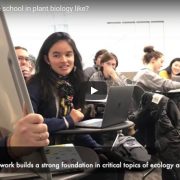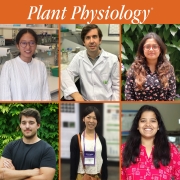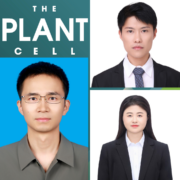Informational Interview with Prof. Vance Baird Professor; Chair, Department of Horticulture at Michigan State University
Informational Interview by Rostislav Blume, ASPB Conviron Scholar
I had honor to interview Prof. William Vance Baird, who is recently Chair at Department of Horticulture in Michigan State University. I had pleasure to meet Prof. Baird personally some time ago, so I asked him to share his thoughts on questions that you can check below.
Prof. Vance Baird’s page at MSU: https://www.canr.msu.edu/people/dr_william_vance_baird
LinkedIn Profile: https://www.linkedin.com/in/va…
ResearchGate Profile: https://www.researchgate.net/p…
What brought you to plant science?
Two things – having spent time in my grandfather’s vegetable garden each summer as a child, and doing a poor job of ‘pithing’ a frog in my first biology dissection class (and listening to it scream because it was insufficiently anesthetized) – no more whole animal science or medicine for me after that!!
Where did you get Ph. D. and what was the topic?
I earned my Ph.D. from the University of Virginia, in the Biology Department – working for the only plant scientist in the entire department (everyone else worked on model animal systems). During my PhD years I studied the development (morphology, anatomy and ultrastructure) of a unique multicellular plant organ – the haustoria (primary and secondary). These are developed on radicals and roots of “parasitic angiosperms” (a somewhat phyolgentically diverse group), which allow the plants to attach to the roots (or stems in the case of mistletoes) of neighboring plants to acquire water (haploparasites) and nutrients (holoparasites) – many times in response to specific chemical signals (secondary compounds), detected in the soil, as released by the roots of their host plants. Some parasites will only germinate and attach to a very limited few hosts (e.g., beech drops and Conopholis) while others will attach to the roots of any plant – including their own [e.g., Indian paint brush and Rhinanthus (rattle)].
Where you did post-doctoral work? Was it different from research topic of your Ph.D.?
Yes, my postdoctoral work was quite different from my PhD work. I went to a molecular biology lab in the University of Georgia’s (Population and Molecular) Genetics Department because I wanted to learn about the plant nuclear genome, its structure and the regulation of gene expression. My advisor/mentor wanted someone knowledgeable in plant growth and development, with experience in plant anatomy and cell biology (which is what I worked on for my MS and PhD) — to help expand the plant biology expertise in his lab.
Which topics you were working on?
For my postdoctoral research, I characterized the actin gene family, in the model genetic system of diploid Petunia [lines developed by Prof. Tom Gerats, then at the Univ. of Ghent (Belgium)], which had at least one phenotypic marker for each chromosome. I developed homology methods to clone the actin genes from genomic libraries. It turned out to be a super family of ~6-8 functional genes and MANY pseudo-genes. I used RFLPs (!!) to map their locations – which was spread around the entire genome. Also, I initiated studies investigating their developmental and tissue-specific expression.
Have you had a mentor during your career path?
Yes, but typically I didn’t recognize how profoundly they impacted/helped me when I was working with or for them! They were an electronics teacher in high-school (Mr. Scott), a chemistry instructor in junior college, a professor at Oregon State (Fred Rickson) where I was an undergraduate, the department chair during my Master degree (Charles Heimsch), a member of my PhD committee at UVa (F.C. Steward), and the mentor during my postdoc at the University of Georgia (Rich Meagher).
What do you like the most about your job? (or the least?)
When I was a young faculty member I very much liked discovering new information about system that now one knew before [how cells divided to form new structures, how genomes were structured and the genetic material organized, how gene expression is controlled and can be modified/manipulated (naturally and biotechnologically), etc.]. However, for the past decade my research efforts have dwindled as my position as Chair of the Horticulture Department has become 100% administration. Now I find satisfaction in helping provide/create a working environment where others (individually or as teams) make those new scientific discoveries — and develop practical recommendations through the application of their findings to help growers sustainable manage production, and increase yields and the quality of horticultural/specialty crops.
What kind of skills should I focus on as a student who is about to finish?
Try to be as broadly trained/experienced as possible – the more you know about a variety of biological systems, the better you will be at asking insightful questions and successfully answering them in whatever system you choose to work. I am routinely disappointed by how many students/plant scientists know so little about model non-plants: animal (mouse, frog), insect (fruit fly, nematode), fungal (slime mold), algal (Chlamydomonas), bacterial (E. coli) and viral (Phage) biological systems. Thus, they approach plant science form a single dimension/point of view.
Anything else you would like to share with the ASPB Scholars?
I must say that both your parents have been an inspiration to me. To see their remarkable ability to build such highly successful scientific careers, with international reputations, and create such a rich and stimulating family life for your whole family – and do so in a country as historically rich and intellectually gifted, yet politically challenging, as Ukraine. Furthermore, your father’s invitation for me to participate in various professional meetings (and thus get to travel to and around Ukraine) was a major advancement in both my scientific career and my personal life.








